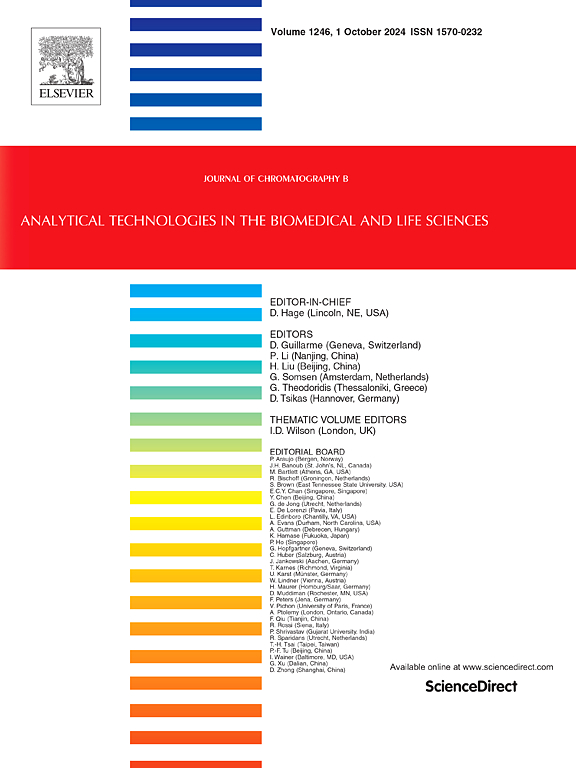Simultaneous separation on a bisphenylureido β-cyclodextrin column and determination of eight antihistamine enantiomers in human plasma by HPLC
IF 2.8
3区 医学
Q2 BIOCHEMICAL RESEARCH METHODS
引用次数: 0
Abstract
A bis(3,5-dichlorophenylureido)-β-cyclodextrin stationary phase (CUCDP) was prepared and characterized. It had strong chiral separation abilities for antihistamines (Rs = 1.61–2.58) in isocratic elution, including chlorpheniramine maleate, bromopheniramine maleate, promethazine hydrochloride and trimeprazine tartrate. Based on CUCDP, a new HPLC method for simultaneous separation and determination of the above eight antihistamine enantiomers (Rs = 1.58–1.92) in human plasma by gradient elution was established. The optimized conditions were as follows: a simple sample pretreatment with acetonitrile (ACN) to precipitate protein, a gradient elution of 0.5 % triethylammonium acetate (TEAA, pH = 4.0)-ACN as the mobile phase at a flow rate of 0.5 mL/min, column temperature at 20 °C, a photo-diode array detector (PDA) at 260 nm, and the sampling volume of 10 μL. The good linear relationships for all enantiomers were observed in the concetration range of 0.25–10.0 μg/mL (R2 = 0.9986–0.9993). The average recoveries were 84.80 %–103.30 % with the RSDs of 1.24 %–2.26 % (n = 5). The limits of detection (LODs) and limits of quantification (LOQs) were 0.015–0.05 μg/mL and 0.05–0.15 μg/mL, respectively. At present, the reported cyclodextrin-based CSPs had not such separation ability for antihistamines by HPLC. However, the new CUCDP exhibited high chiral selectivity for antihistamines, which was mainly related to the introduction of bisphenylureido group into the rim of cyclodextrin, and the strengthening of hydrogen bonding, π–π stacking and inclusion between CUCDP and analytes. This method could save analysis time, reduce solvent consumption, and improve efficiency at low cost.

双苯脲β-环糊精柱同时分离及HPLC测定血浆中8种抗组胺对映体
制备了双(3,5-二氯苯脲)-β-环糊精固定相(CUCDP)并对其进行了表征。对马来酸氯苯那敏、马来酸溴苯那敏、盐酸异丙嗪和酒石酸三美嗪等抗组胺药具有较强的手性分离能力(Rs = 1.61 ~ 2.58)。以CUCDP为基础,建立了梯度洗脱同时分离测定人血浆中上述8种抗组胺对映体(Rs = 1.58 ~ 1.92)的高效液相色谱方法。优化条件为:以乙腈(ACN)作为样品的简单预处理,沉淀蛋白质,以0.5%醋酸三乙胺(TEAA, pH = 4.0)-ACN为流动相梯度洗脱,流速0.5 mL/min,柱温20℃,光二极管阵列检测器(PDA)在260 nm,进样量10 μL。各对映体在0.25 ~ 10.0 μg/mL范围内呈良好的线性关系(R2 = 0.9986 ~ 0.9993)。平均加样回收率为84.80% ~ 103.30%,rsd为1.24% ~ 2.26% (n = 5)。检测限(lod)为0.015 ~ 0.05 μg/mL,定量限(loq)为0.05 ~ 0.15 μg/mL。目前已报道的环糊精基csp对抗组胺类药物不具备高效液相色谱分离能力。而CUCDP对抗组胺药物表现出较高的手性选择性,这主要与在环糊精边缘引入双苯脲基以及CUCDP与分析物之间的氢键、π -π堆积和包合增强有关。该方法可节省分析时间,减少溶剂消耗,以低成本提高分析效率。
本文章由计算机程序翻译,如有差异,请以英文原文为准。
求助全文
约1分钟内获得全文
求助全文
来源期刊

Journal of Chromatography B
医学-分析化学
CiteScore
5.60
自引率
3.30%
发文量
306
审稿时长
44 days
期刊介绍:
The Journal of Chromatography B publishes papers on developments in separation science relevant to biology and biomedical research including both fundamental advances and applications. Analytical techniques which may be considered include the various facets of chromatography, electrophoresis and related methods, affinity and immunoaffinity-based methodologies, hyphenated and other multi-dimensional techniques, and microanalytical approaches. The journal also considers articles reporting developments in sample preparation, detection techniques including mass spectrometry, and data handling and analysis.
Developments related to preparative separations for the isolation and purification of components of biological systems may be published, including chromatographic and electrophoretic methods, affinity separations, field flow fractionation and other preparative approaches.
Applications to the analysis of biological systems and samples will be considered when the analytical science contains a significant element of novelty, e.g. a new approach to the separation of a compound, novel combination of analytical techniques, or significantly improved analytical performance.
 求助内容:
求助内容: 应助结果提醒方式:
应助结果提醒方式:


